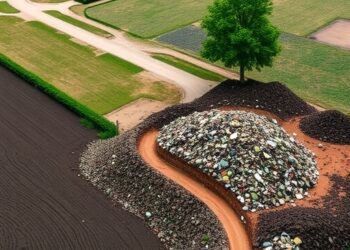A recent study published in the journal Communications Earth and Environment sheds light on an intriguing aspect of paleoclimate research: the remote input of African dust to Europe during the Last Glacial period. This research led by a team of scientists, including Rousseau DD, Chauvel C, and Hopcroft PO, uncovers the nuances of how dust transport mechanisms impacted glacial Europe’s ecosystem and climate. The study emphasizes the significance of atmospheric conditions and provides pivotal insights into the connections between continents through the transport of mineral dust.
The authors employed an integrated approach, combining various data points, models, and empirical research techniques to unravel the extent of African dust’s influence on the climatic conditions of Europe during historical glacial periods. Understanding these dust transport processes is not only crucial for reconstructing past climates but also essential for predicting future climate behaviors, especially in response to ongoing anthropogenic changes.
The study illustrates how subtle variations in wind patterns can lead to significant interactions between vast geographic regions. By analyzing sediment cores retrieved from various locations across Europe, the researchers identified layers containing traces of African mineral dust. These layers served as important indicators of past atmospheric circulation patterns, revealing that dust was indeed transported over long distances to deliver nutrients to glacial Europe.
One of the most fascinating revelations from the study is the timing and frequency of dust deposition events. The researchers noted that during specific glacial intervals, there were peaks in dust deposition correlated with other climate events, suggesting that changes in global temperature and precipitation patterns played a role in the transport and deposition of this dust. Such findings add complexity to our understanding of Earth’s climatic past, highlighting the dynamic interplay between the atmosphere, biosphere, and geology.
To quantify the dust contribution from Africa, the research team utilized advanced modeling frameworks which incorporated atmospheric and oceanic data. This multidisciplinary approach enabled them to simulate potential dust transport scenarios under different climate conditions. The models indicated that alterations in wind strength and direction significantly influenced the frequency of dust outbreaks, allowing particles to traverse thousands of kilometers, thus illustrating the power of atmospheric circulation.
Moreover, the implications of the study extend beyond just understanding glacial dynamics. The transported African dust also presented itself as a critical nutrient source for European ecosystems, characterized by high levels of iron and other minerals that enhance productivity in terrestrial and aquatic environments. This nutrient input may have played a vital role in shaping the biodiversity and ecological complexity of Europe during glacial times, creating conditions favorable for various life forms to thrive amidst harsh climates.
The study’s findings provoke further questions about the potential impacts of increased dust mobilization due to current and future climate conditions. With increasing desertification and alterations in land use in Africa, there’s a growing concern that dust emissions could lead to altered climate patterns not only in Europe but globally. Thus, understanding the historical precedents of dust transport provides a conceptual framework to anticipate future climate scenarios exacerbated by human-induced changes.
In a world where climate policies are increasingly influenced by historical climate data, the contributions of this research cannot be understated. By elucidating the mechanisms of dust transport from Africa to Europe and its resultant climatic impacts, the study serves as a clarion call for a more nuanced understanding of intercontinental interactions in climatic phenomena. It also underscores the importance of comprehensive climate models that incorporate dust dynamics in their simulations.
As a vibrant area of ongoing research, the relevance of dust transport studies is only expected to grow. Scientists are now faced with the challenge of deciphering the complex interactions between atmospheric particles and climate systems. The findings from this research push the boundaries of our knowledge and highlight the potential for further studies to explore other regions affected by similar processes.
As climate events become increasingly extreme in the 21st century, the history we unveil from events like the Last Glacial period will be vital to our preparedness and responsiveness to current challenges. Enriching our perspectives on geophysical processes and climatic shifts not only informs our understanding of the past but also equips society with the knowledge necessary to navigate the future more effectively.
In summary, this research unravels the intricate relationships between dust transport from Africa and its climatic implications for glacial Europe. By bridging gaps in our understanding of these processes, Rousseau and colleagues pave the way for further investigations that could illuminate the broader implications of dust on the global climate system.
Subject of Research: Remote input of African dust to Europe during the Last Glacial period.
Article Title: A remote input of African dust to Last Glacial Europe.
Article References:
Rousseau, DD., Chauvel, C., Hopcroft, P.O. et al. A remote input of African dust to Last Glacial Europe.
Commun Earth Environ 6, 847 (2025). https://doi.org/10.1038/s43247-025-02888-9
Image Credits: AI Generated
DOI: https://doi.org/10.1038/s43247-025-02888-9
Keywords: African dust, Last Glacial period, climate change, atmospheric circulation, glacial Europe, nutrient transport, paleoclimate research.




